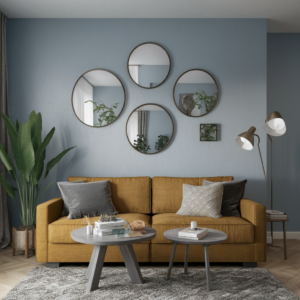Mirror at the Wall
Mirrors have long captivated human creativity, serving as realistic tools and symbolic items in artwork, literature, and lifestyle. Their potential to mirror light and create illusions has made them worthwhile in interior layout, psychology, and stagecraft. Mirrors were strategically positioned from the palaces’ hallways to the actors’ dressing rooms to beautify the area, light, and attitude. This exploration delves into the complicated interaction between mirrors, mild, and illusion, uncovering the secrets and techniques behind their strategic placement.
The Power of Reflection:
- In its middle, a reflect is a surface that reflects mildly, bouncing it back to create a photo of the gadgets in front of it. These essential assets have profound implications for the room’s notion of area and light. Mirrors can visually amplify a space by increasing the intensity illusion, making small rooms seem more extensive and open. By strategically setting mirrors contrary to home windows or sources of mild, designers can make more considerable natural light, brightening dark corners and imbuing interiors with airiness and energy.
- Moreover, mirrors can serve as focal factors, drawing the attention closer to particular elements of a room or highlighting architectural capabilities. A mirror above a fireplace or in the back of an eating desk adds interest. It enhances the ambiance by reflecting the warm temperature and glow of the surroundings. In this manner, mirrors become dynamic elements of indoor layout, capable of remodeling the mood and surroundings of space with their reflective magic.
Illusions of Space and Perspective:
- The strategic placement of mirrors can also create compelling illusions of area and perspective, playing tricks on our thoughts and altering our belief of fact. One conventional method is using reflected walls in slender hallways or tight corridors. By lining one or both facets of the passage with mirrors, designers can visually double the width of the space, making it appear more expansive and welcoming. This simple yet potent trick has been employed in resorts, restaurants, and retail stores to beautify the consumer experience and create an understanding of grandeur.

- Similarly, mirrors may be strategically located to create the phantasm of intensity in restricted areas, such as alcoves or alcoves. Placing a replicate on the top of a hallway or behind a recessed area of interest extends the visible sightline, making the gap seem more profound than it, without a doubt, is. This technique is helpful in cramped city apartments or business interiors wherein maximizing perceived space is essential for comfort and capability.
- Beyond mere spatial illusions, mirrors can also manipulate perspective subtly, changing the perceived proportions and relationships between objects within a room. Placing a huge mirror on one wall can visually double the fixtures’ dimensions or decorative factors in front of it, developing a feel of stability and harmony. Similarly, mirrors can reflect perspectives of the outdoors, seamlessly integrating the interior with the surrounding panorama and blurring the boundaries between inside and outside.
Lighting Effects and Ambiance:
- In addition to their spatial and perspectival residences, mirrors play an essential function in shaping the excellent light distribution within a room. By strategically positioning mirrors to mirror herbal or synthetic light sources, designers can beautify illumination stages and create dynamic lighting fixture effects that beautify the atmosphere and mood.
- In rooms with limited right of entry to natural light, such as basement spaces or windowless interiors, mirrors can act as virtual windows, bringing in brightness and warmth. Placing mirrors opposite or adjoining to artificial mild furnishings, together with lamps or sconces, amplifies their luminosity, correctly doubling the brightness and spreading it for the duration of the room. This approach is precious in residential settings where growing a bright and alluring environment is essential for consolation and well-being.
- Moreover, mirrors may be used to control the path and depth of mild, casting charming shadows and reflections that animate the gap. By angling mirrors in the direction of precise regions or surfaces, designers can create dramatic lighting results that highlight architectural details or focal points. This interaction of mild and shadow provides intensity and size to interiors, reworking static environments into dynamic compositions that evolve with the changing illumination angles.
Psychological Impact and Emotional Resonance:
- Beyond their sensible functions, mirrors exert a practical psychological effect on human perception and behavior. From early life video games of peek-a-boo to the existential contemplations of self-reflection, mirrors evoke an extensive range of feelings and institutions that shape our relationship with the encompassing surroundings.
- Mirrors are regularly used strategically in interior layouts to evoke openness, expansiveness, and optimism. By reflecting light and space, mirrors create a sense of airiness and freedom that counteracts feelings of confinement or claustrophobia. In healthcare settings, mirrors beautify affected persons’ well-being by developing an experience of connectivity and continuity with the outside global. Similarly, mirrors are utilized in healing contexts to facilitate self-exploration and promote emotional restoration via introspection and self-focus.
- Moreover, mirrors may create intimate and immersive environments that foster rest and contemplation. By strategically putting mirrors in secluded alcoves or non-public chambers, designers can craft intimate sanctuaries wherein people can retreat from the outside international and interact in moments of quiet mirrored image. This blending of bodily area and internal revel creates a sense of sanctuary and haven, presenting solace and luxury in a more chaotic and fragmented international. For example, mirrors have held a significant vicinity in human culture and mythology, serving as portals to different geographical regions, symbols of arrogance, and windows to the soul. The attraction of mirrors lies now not just in their reflective surfaces but inside the myriad methods they shape our perceptions and experiences of the world around us.
- In the realm of indoor design, mirrors are necessary equipment for developing areas that are both visually fascinating and functionally green. Whether used to extend natural light, make more enormous spatial obstacles, or decorate architectural features, mirrors have the energy to convert ordinary rooms into first-rate environments that engage the senses and increase the human spirit. One of the critical components of replicate placement is knowing the ideas of light and how it interacts with unique surfaces. Mirrors can be strategically located to seize and reflect natural mild, doubling its impact and illuminating even the darkest corners of a room. By setting mirrors contrary to home windows or doors, designers can leap daylight deeper into an area, developing a feel of warmth and vitality that uplifts the temper and complements the overall atmosphere.
Conclusion:
In the end, the strategic placement of mirrors is a nuanced artwork that encompasses concepts of mild, illusion, psychology, and emotion. From expanding spatial obstacles to manipulating angle and lighting effects, mirrors are versatile tools that can remodel the belief and enjoyment of indoor environments. By harnessing their reflective magic, designers can create dynamic areas that engage the senses, evoke feelings, and inspire contemplation. In the words of the timeless fairy story, «Mirror, reflect on the wall,» the electricity of mirrors lies no longer simplest in their capacity to reflect bodily truth but additionally in their capability to mirror the depths of the human soul.
FAQs:
- What is the main focus of the exploration mentioned in the text?
- The exploration focuses on the complicated interaction between mirrors, light, and illusion.
- How have mirrors been used historically in human creativity?
- Mirrors have been used both as realistic tools and symbolic items in artwork, literature, and lifestyle.
- What are some practical applications of mirrors mentioned in the text?
- Mirrors are used in interior layout, psychology, and stagecraft due to their potential to reflect light and create illusions.
- How do mirrors impact the perception of space and light in a room?
- Mirrors can visually amplify a space, making small rooms seem more extensive and open. They also enhance natural light by strategically reflecting it.
- What is the basic function of a mirror?
- A mirror is a surface that reflects light, bouncing it back to create a reflection of the objects in front of it.
- How do designers use mirrors to enhance interior spaces?
- Designers strategically place mirrors opposite windows or sources of light to increase natural light and brighten dark corners, imbuing interiors with airiness and energy.
- What is the significance of mirrors in stagecraft?
- Mirrors are used in stagecraft to create illusions and enhance the atmosphere by reflecting light and space.
- How have mirrors been historically used in palaces and dressing rooms?
- Mirrors have been strategically positioned in palaces’ hallways and actors’ dressing rooms to enhance space, light, and attitude.
- How do mirrors contribute to the perception of depth in a room?
- Mirrors create an illusion of depth by reflecting the space in front of them, making the room appear larger and more spacious.
- What are some implications of mirrors in interior design?
- Mirrors can play a significant role in interior design by enhancing natural light, creating illusions of space, and adding depth to a room.
